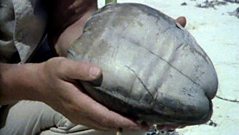
Giant nuts
Huge Coco-de-Mer nuts come from palms endemic to the Seychelles.
Some island plants are very different from their nearest relatives. Standing on a beach on the island of Aldabra, David Attenborough holds up a huge double nut called a Coco-de-Mer, a huge seed occasionally washed up here. For centuries no-one knew where they came from and it was suggested they were from undersea palm trees, hence the name. Superstitions said their kernels could be made into a love potion or cure any poison. These nuts were therefore worth a fortune. In the 18th century, people discovered that the palms that produce the nuts grow in one tiny group of islands in the Seychelles, 700 miles from Aldabra. The largest surviving Coco-de-Mer palms grow on Praslin Island. There are both male and female trees. The males produce small yellow flowers on long spikes, on whose nectar and pollen there feeds a certain gecko that is slightly different in colour to the geckos on neighbouring islands. The female flowers start as small reddish buds that are no bigger than a fist but they eventually develop, over seven years, into the biggest seed produced by any plant. When the seeds are mature they are so big and heavy that the only way to open them is with a saw. Although they look vaguely like coconuts from the outside, once they are sawn open it can be seen that they have a double-lobed structure and are very heavy with flesh. In fact, the flesh is so heavy that the mature nuts can not float in seawater, and are even killed by it. This means that they cannot naturally colonise other islands and that they must therefore have evolved on this tiny group of islands.
Duration:
This clip is from
Featured in...
![]()
成人快手 Nature
Be captivated, informed and inspired by the world's wildlife.
More clips from Worlds Apart
-
![]()
Ocean Drifters
Duration: 01:20
-
![]()
Safe haven
Duration: 01:13
-
![]()
Outgrown defense
Duration: 01:31
-
![]()
Testing times
Duration: 02:34
More clips from The Living Planet
-
![]()
Ocean Drifters—Worlds Apart
Duration: 01:20
-
![]()
Snare of silk—The Baking Deserts
Duration: 01:48
-
![]()
Furnace flora—The Baking Deserts
Duration: 03:46
-
![]()
Ships of the desert—The Baking Deserts
Duration: 03:17









